Fly Rod Guides!
Your source for flyfishing and flycraft resources since 1975.
| Illusion Conventional Snake Running Guides | 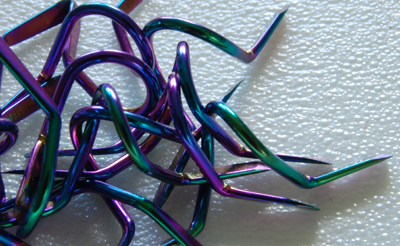 |
|---|
There are 3 sets of items we refer to when talking about fly rod guides: tip top, running guides and stripping guides.
Tip Tops
The tip top is, as you might think, is actually the top 'guide' on your fly rod. It can be conventional, which is what most of us are familiar with, 'Large Loop' which is exactly as it sounds or with a ceramic insert.
| Conventional | Large Loop | Ceramic Insert |
|---|---|---|
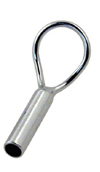 |
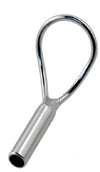 |
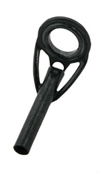 |
Typically, we use the conventional tip tops on most rods, but where heavier weight lines are used, we favor the large loop top. If you think about it, heavier weight lines are thicker and the knots we use with them are also bigger, so using a larger top makes sense in this case. The ceramic insert top has a ring of some aluminum oxide, zirconia or silicon carbide. These are very hard materials, resistant to abrasion, wear resistant and very smooth. The ceramic insert may also allow the line to glide with less friction, which can be important when casting distances are lengthy.
Running Guides
Running guides are those from the main set of guides that 'run' down most of the length of the fly rod. They may be Conventional (double foot) snake guides, single foot 'snake' guides or single foot with a ceramic insert.
| Conventional | Single Foot | Ceramic Insert |
|---|---|---|
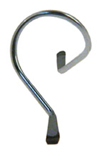 |
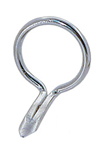 |
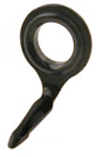 |
The single foot guides are usually a thick guage material than the conventional guides in order to add strength. Also many use the double foot guides for rods of 7 weight and over, it is rare to lose or break a guide as a result of regular use. There is always room to debate the drawbacks and advantages of each, but despite the differences in weight, smoothness and so on, we recommend that you use whichever appeals to you or to try them all.
Stripping Guides
These are the larger, almost always double footed, guides closest to the rod's grip. There may be up to 3 of these, depending upon the length of the rod. Almost all have a ceramic insert of some type.
| Chrome/Ceramic | Black/Ceramic | TiCh/Ceramic | TiCh/Gold Zirconia |
|---|---|---|---|
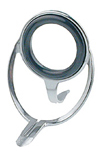 |
 |
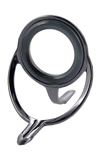 |
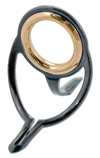 |
You might think that all of the guides should always match, but this is an area where we encourage you to be creative. Recently, we've seen some high end rods where the insert on the stripping guides were gold, and the end result is gorgeous.
Materials/Plating
Almost all guides are made of a strain of corrosion resistant stainless steel. In addition, most are plated; the plating adds to the aesthetics of the rod as well as providing further corrosion resistance. We'll discuss these briefly.
- Chrome - this is the most common plating available.
- Black - actually painted on in most cases
- TiCh - often misrepresented as 'titanium,' this is a beautiful coating which is a dark grey color actually made from a titanium chrome alloy. Actual color can vary among manufacturere
- Gold/Titanium Alloy - these will make a very, very classy rod
- Titanium - solid titanium are strong, light and impervious to corrosion, made by American Tackle
- Titanium/Nickel Alloy - Recoil brand by REC, light, cannot corrode and will retain original shape when bent
There are, of course, variations of the above, but I'm sure you get he idea. There are also newer styles of strippers that are actually pretty cool, so check them out in our store. Do not be afraid to try new or different products.
Materials/Inserts
You won't be surprised that there is a lot of debate here too, but we'll make this real simple. Some builders will argue that the less friction you have on your line, the further you can cast! Well duh! But the question really becomes, will the 'difference make a diffence' for your style of fishing and casting. If you're casting long distances, then harder guides inserts may make a difference small difference. The different materials may also wear a bit differently after prolonged usage.
| Hardest | Very Hard | Pretty Darn Hard |
|---|---|---|
| SIC or Silicon Carbide | Zirconium | Aluminum Oxide |
You'd be hard pressed to need guides with inserts any harder than aluminum oxide, and it is the standard in our Hook & Hackle guide sets. But there are reasons to use the others. For instance, Zirconum can take platings in some very attractive colors including gold, blue and illusion. And SIC guides are definitely the way to go if you simply must have the very best!
Hookkeeper
There are basically two kinds of hookkeepers: 'U' shaped and folding.
Grinding the Guide Foot
Feet of the guides are ground to make a smooth transition when you wrap a guide 'up the foot.' All of the guides we sell have pre-ground feet and you don't have to smooth them any further. Stil, some builders do in order to get each guide on absolutely perfectly. This is mostly unnecessary.
Final consideration
At the top of this page is one of our favorite photographs of 'Illusion' guides. This is a special coating, not inexpensive, but beautiful to see. Traditionally, fly rods have a conservative look to them, but we strongly encourage you to try some of the new colors and materials available on the market today. My favorite rod has multi-color snake guides, tip top and hookkeeper and purple thread wraps. Everywhere I go, people want one just like it. And, by the way, it's caught some huge fish! They don't, in most cases, care what your rod looks like! It's for you, so enjoy!
Solid titanium and the titanium/nickel alloy are light and sexy, but cost a bit more. They're also fun to use and are the guides of choice of some of the finest rod manufacturers in the world!






